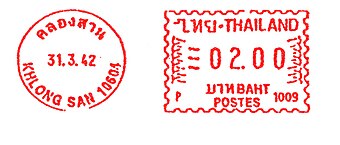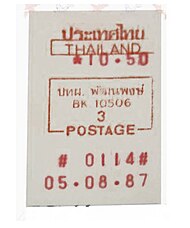International Postage Meter Stamp Catalog/Thailand
Thailand[edit | edit source]
- The first postage meters were used in 1952.
- All stamps are inscribed “THAILAND”.
- Essays from 1928 with the country’s former name, “SIAM”, exist.
- The stamps are grouped according to appearance and usage:
- A – Franks with outer frame line and separate town mark
- B – Digital stamps with 2D barcode
- PO – Stamps generated only by special Post Office machines
- PV – Variable rate stamps generated by self-service vending machines
GROUP A: Franks with outer frame line and separate town mark[edit | edit source]

- A1. Universal “MultiValue” (MV), 1 May 1952.
- Horizontal frank with simulated perforation outer border and straight inner border.
- Country name in curved panel at top with triangular ornaments in the upper corners.
- M# with “U” prefix in boxes at bottom with “POSTES” between.
- Value figures variable in thickness.
- TM: DC
- V/F: 00oo
- a. Post Office stamp. Meter U1 was used in the Bangkok Central Post Office.


- A2. Universal, later Pitney Bowes “Automax” (MV), 1970.
- Very similar to Type 1 but the ‘perforation holes’ in the outer frame line are smaller, and the value figures are of uniform thickness.
- A. M# with “U” prefix (Universal)
- B. M# with “P” prefix (Pitney Bowes)
- TM: DC
- V/F: =0.oo

- A3. Pitney Bowes-GB “5000” series (MV), 1970.
- Horizontal frank wider and shorter than with Types A1-A3.
- Triangles in upper corners are without ornament.
- M# with “P.” prefix in boxes at bottom.
- Small “POSTES” breaks bottom frame line.
- TM: DC, SC
- V/F: ≋0.00
- a. With Thai instead of Western year date

- A4. Kilburn (MV), 1979. [Meter K9 is very rare, the others numbers are extremely rare]
- Square frank with single-line simulated perforation border.
- Meter number and prefix in floating boxes at bottom.
- M# with “K” prefix.
- Ten machines only were used, most being withdrawn quite early. Meter K9 was used longest.
- TM: DC
- V/F: 00.00

- A5. Hasler “Mailmaster” (MV), 1980.
- Very similar to Type A2 but only two parallel lines under “POSTES” instead of five.
- Spacing between the TM and frank is narrower than with Type A2.
- M# with “H” prefix
- TM: DC
- V/F: 00.00
- a. With Thai instead of Western year date

- A6. Pitney Bowes-GB “6300” (MV), 1983.
- Small, horizontal frank with single-line simulated perforation border.
- Scrollwork ornaments at sides.
- M# with “P.” prefix in lower corners.
- TM: DC or SC
- V/F: ≋ 0.00
- a. With Thai instead of Western year date

- A7. Pitney Bowes-GB “6600” (MV).
- Similar to Type A5 but taller.
- M# with. “P” prefix
- TM: DC
- V/F: ≋ 0.00
- a. With Thai instead of Western year date

- A8. Pitney Bowes “A/B900” series (MV).
- Similar to Type A5 but slightly wider and with larger, 5-bank value figures.
- M# with “P” prefix.
- TM: SC
- V/F: ≋00.00
- a. With Thai instead of Western year date

- A9. Neopost Alcatel “Electronic” (MV), 1995.
- Horizontal frank with straight line border.
- Country name in horizontal panel at top.
- M# with “A” prefix flanking “BAHT” at bottom
- TM: SC
- V/F: 00.00
GROUP B: Digital stamps with 2D barcode[edit | edit source]

B1. Pitney Bowes "DM1000" (digital), December 2008.
- Frameless, horizontal frank with 'paper airplane' design at top center above the baht currency symbol.
- Vertical 2D barcode at far left.
- "THAILAND POST" at top right above the value figures, date, and 5-digit number.
- At left are a number with "P. prefix, a 6-digit number, and the town name.
- V/F: (000)0.00
GROUP PO: Stamps generated only by special Post Office machines[edit | edit source]


PO1. Matsushita Electric Company (MV), 4 August 1987. [Scarce]
- Upright frank in red on plain adhesive tape without outer frame.
- Country name in Thai at top above two horizontal bars with the value figures in between.
- “POSTAGE’ breaks the upper bar.
- The town mark and country name in English are at center
- A transaction number and the date are at bottom.
- A. “POSTAGE” 10 mm wide
- B. Small “POSTAGE” 7 mm wide (shown at right)
- V/F: ★(00)0•00

PO1.1. Matsushita Electric Company (MV). [Appears to be rare]
- Similar to Type PO1 but with "THAILAND" boxed at top and the post office identification boxed at center.
- "POSTAGE" breaks the center box at its bottom.
- V/F: ★(00)0•00
NOTE: This may be an experimental design used for only a short time or at a single location.





PO2. Unidentified local manufacturer (digital), 2000.
- Horizontal, unframed design printed in black on adhesive labels with serpentine 'perforations' at the sides.
- Illustration of elephants at right below English country name.
- Value figures below elephants, and various data including date and machine number at left.
- A. Label with very faint horizontal lines [Scarce]
- B. Plain white label with fluorescent red stripe across top (2001)
- C. Plain white label with inscription in blue and red across bottom, small characters (2004)
- D. As C but the characters are larger (2006)
- V/F: ≋(00,00)0.00
- a. As D but the text and numbers are somewhat lighter, the date figures have footed 1's, and the date elements are separated by dashes instead of dots. These differences may represent a different machine model.
NOTES:
- Sub-type PO2A labels tend to fade. Keeping them away from light has no affect. Sub-types PO2B, C, and D do not have this problem.
- Many minor variations of Type PO2, and Type PO3 below, can be found. The differences are in the font and font size and also in the image of the elephants. It is probable that Thai Post tweaks the operating system in these machines frequently.

PO3. Unidentified local manufacturer (digital), 2008.
- As PO2D but value figures are different, narrower and thicker, and with a wide space between the "≋" and the first digit.
- V/F: ≋ (00,00)0.00
- a. Value figures without "≋"
NOTE: See the second Note below Type PO2.




- PO4.1. Unidentified local manufacturer (digital).
- Stacked at left: country name in English, transaction number, date and time, "POSTAGE".
- Stacked at right: country name in Thai, weight, origin post code, value figures.
- A. Used on ordinary mail, with elongated elephant above the preprinted "THAILAND POST" logo
- B. Used on registered mail, with registration number and RR left of barcode. No elephant.
- C. Used on express mail, with E and second letter left of barcode. No elephant.
- V/F: B(0000)0.00 BAHT
- a. With recipient's name added below value figures
- b. With additional postage amount at left immediately above POSTAGE. This is the amount of postage pre-affixed when the mail piece was handed to the postal clerk.
- c. Printed on label with the Thailand Post logo printed in a colorless ink that can be seen only under ultraviolet light. (See Type PO4.2)




- PO4.2. Unidentified local manufacturer (digital).
- Very similar to Type PO4.1 but the Thailand Post logo across the bottom is printed in a colorless ink that can be seen only under ultraviolet light.
- A. Used on ordinary mail
- B. Used on registered mail, with registration number and single large R at left
- C. As B but with two smaller italic RR's left of barcode
- D. Used on express mail, with E and second letter left of barcode. No elephant.
- V/F: B(0000)0.00 BAHT
- E. With large U at left. The service this indicates needs identification.
- a. With Thailand Post logo upside-down
- b. With recipient's name added below value figures
NOTE: The year in the date has been found in both the Western calendar (2018) and the Thai calendar (2561).


GROUP PV: Variable-rate stamps generated by self-service vending machines[edit | edit source]

PV1. Thailand Post in cooperation with a local university (digital), 2006.
- Label imperforate along top and bottom and with serpentine 'perforations' at the sides as used with types PO2 and PO3.
- With barcode at bottom above the Thailand Post logo in blue and red (as found on type PO2D).
- Ten machines were trialed in the Bangkok area.
- The date is printed on the label, and they are valid only on the date of purchase.
- V/F: B00.00
- a. BAHT misspelled as BATH (shown)
The Hasler "Mailmaster" stamp shown below was found on a mailed cover. It is inscribed entirely in Thai except for the town name at the bottom of the town mark. The status of the stamp is uncertain, but it may be a design used only for internal or local mail.
